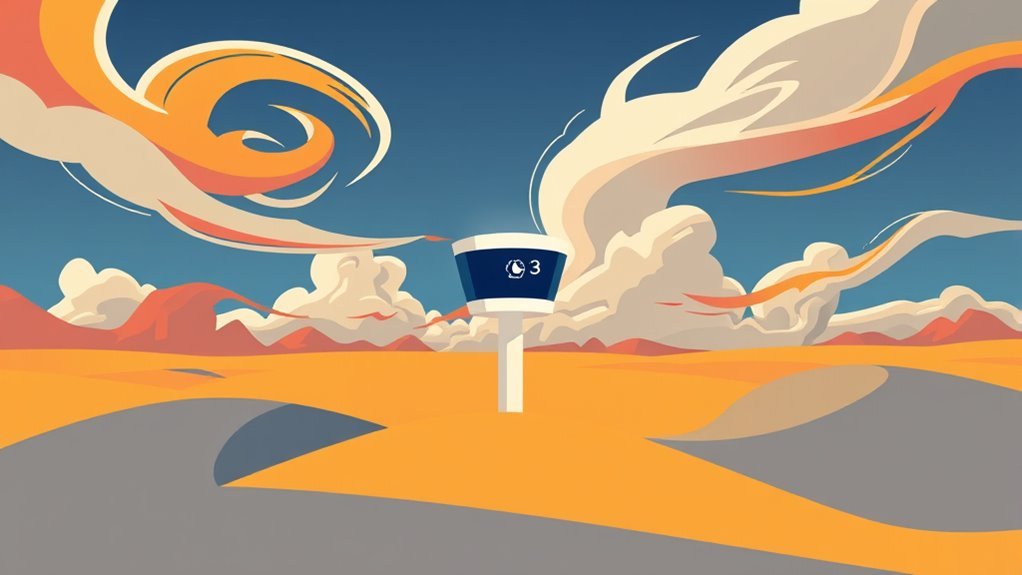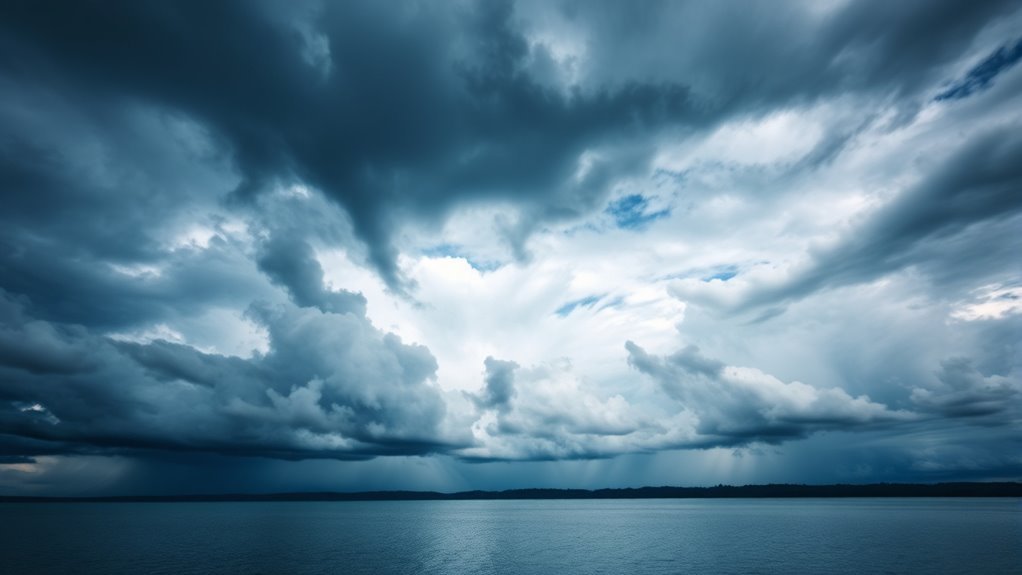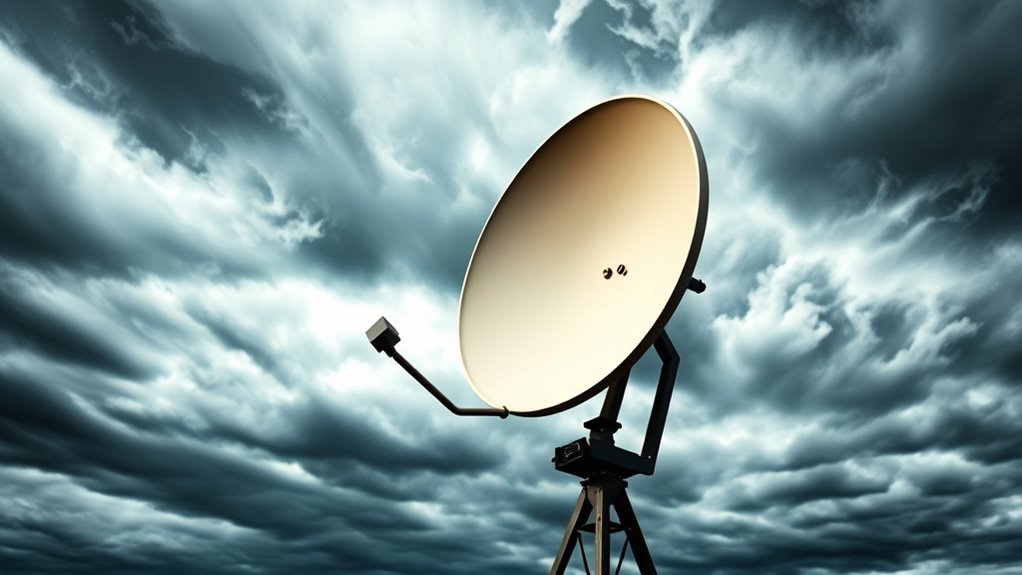Doppler radar images play an essential role in displaying squalls and their wind patterns. They use electromagnetic waves to detect precipitation and measure the frequency of returned signals. This data indicates sudden shifts in wind speeds and helps identify squall lines. Bright areas on the radar signify intense precipitation, while contrasting colors reveal changes in wind direction. Such observations are important for accurate weather forecasting. Further exploration uncovers more about the technology's applications and advancements.
Main Points
- Doppler radar images visualize squalls by displaying bright, concentrated areas indicating intense precipitation and rapid wind changes.
- Frequency shifts in radar waves help determine wind speed and direction, revealing squall patterns and their movement.
- Velocity data contrasts wind patterns, clearly showing abrupt changes associated with squalls and their potential hazards.
- The duration of radar signatures aids in assessing how long squalls will impact specific areas, enhancing forecasting accuracy.
- Combining radar data with surrounding weather systems provides a comprehensive understanding of squalls and their implications for safety and preparedness.
Understanding Squalls: Definition and Characteristics
Squalls are sudden, intense bursts of wind and rain that can greatly impact weather conditions. These phenomena typically occur during storms, defined by a rapid increase in wind speed followed by heavy precipitation.
Often lasting for a short duration, squalls can emerge unexpectedly, leading to hazardous conditions for those caught in their path. The wind associated with squalls can reach speeds of 30 knots or more, resulting in dangerous gusts that can uproot trees and damage structures.
The precipitation during a squall can vary from light rain to torrential downpours, frequently accompanied by brief periods of hail or even snow in colder climates. Visibility may diminish considerably, posing risks to travelers.
Squalls can occur in various environments, from coastal regions to inland areas, making them a critical concern for meteorologists and the public alike. Understanding their traits is essential for effective forecasting and preparedness.
The Science Behind Doppler Radar Technology

Doppler radar technology utilizes the principles of electromagnetic waves to detect and measure the speed and direction of precipitation and wind patterns.
By analyzing the frequency shifts of these waves, meteorologists can interpret various atmospheric conditions and predict squalls.
This technology serves as an essential tool in understanding complex weather phenomena and enhancing forecasting accuracy.
Radar Technology Basics
Radar technology serves as an essential tool in meteorology, enabling the detection and analysis of atmospheric phenomena. It operates by emitting radio waves that bounce off precipitation particles, returning to the radar system. This process allows meteorologists to visualize rain, snow, and other weather events in real-time.
Doppler radar, a specialized form of radar, measures the frequency shift of the returned waves, providing information about the movement of precipitation and wind speed. By analyzing these signals, meteorologists can identify areas of intense precipitation and potential severe weather.
The technology is vital for timely warnings and forecasts, greatly enhancing the understanding of storm dynamics and atmospheric behavior. Its applications extend beyond meteorology, impacting aviation, maritime operations, and emergency response.
Wind Pattern Interpretation
Understanding wind patterns is a critical aspect of meteorology that can be effectively analyzed through advanced radar technology.
Doppler radar employs the Doppler effect to measure the frequency change of returned radar waves, allowing meteorologists to detect wind speed and direction. By interpreting these radar images, professionals can identify squall lines, which are associated with abrupt changes in wind patterns.
The data reveals the intensity and movement of winds, contributing to the prediction of severe weather events. Additionally, the technology can visualize complex wind interactions such as turbulence and shear, providing understandings into atmospheric dynamics.
Consequently, Doppler radar serves as an essential tool for improving weather forecasting accuracy and enhancing public safety during storm events.
How Doppler Radar Captures Wind Patterns
Weather observation relies heavily on advanced technology, and one of the most effective tools for capturing wind patterns is Doppler radar. This technology utilizes the Doppler effect, measuring the change in frequency of radar waves reflected off moving particles in the atmosphere. By emitting radio waves and analyzing the returned signals, Doppler radar determines the speed and direction of wind.
The radar identifies not only the intensity of precipitation but also the motion of air masses, allowing meteorologists to visualize wind patterns in real-time. Data collected can reveal critical information about the development of squalls, including their strength and movement.
Doppler radar can also detect turbulent winds and changes in atmospheric conditions that might not be visible through traditional observation methods. Consequently, this technology plays an essential role in forecasting severe weather events and ensuring public safety by enabling timely warnings based on observed wind patterns.
Interpreting Doppler Radar Images of Squalls

While interpreting Doppler radar images, meteorologists focus on the unique signatures that squalls present, which can indicate rapid changes in wind speed and direction. These signatures often appear as bright, concentrated areas of reflectivity, signaling intense precipitation and turbulent airflow.
The radar's velocity data is critical for identifying wind shifts, as squalls typically create a stark contrast between inbound and outbound wind patterns. By analyzing these patterns, meteorologists can determine the squall's intensity and potential for severe weather, such as strong gusts or even tornadoes.
Furthermore, the duration of these signatures on radar helps assess the squalls' movement and impact area. Additionally, interpreting the data requires careful consideration of surrounding weather systems, as squalls can interact with other phenomena, further complicating their behavior.
Ultimately, accurate interpretation of Doppler radar images is essential for understanding and responding to squall-related risks.
The Role of Doppler Radar in Weather Forecasting

Doppler radar serves as an essential tool in modern meteorology, providing real-time data that improves weather forecasting accuracy. By emitting microwave signals and analyzing their return, Doppler radar can detect precipitation intensity, movement, and velocity. This capability allows meteorologists to identify storm systems and assess their development, enhancing predictive models.
The technology excels at tracking severe weather phenomena, such as squalls and tornadoes, which can pose considerable risks to life and property.
Moreover, Doppler radar can distinguish between different types of precipitation, including rain, snow, and hail, offering useful perspectives for localized forecasting. The data collected contributes to numerical weather prediction models, which simulate atmospheric behavior.
Through continuous updates, Doppler radar guarantees that meteorologists are equipped with the latest information, enabling timely warnings and improving public safety.
As a result, the role of Doppler radar remains crucial in advancing weather forecasting capabilities and understanding atmospheric dynamics.
Real-World Applications: Keeping Communities Safe
By utilizing Doppler radar technology, communities can significantly improve their safety measures against severe weather events. This advanced meteorological tool provides immediate data that enables meteorologists to detect squalls and wind patterns with unparalleled accuracy. As a result, timely alerts can be issued, minimizing risks to life and property.
Key practical applications of Doppler radar in enhancing community safety include:
- Early Warning Systems: Issuing alerts for severe weather conditions.
- Disaster Preparedness: Informing emergency response plans based on predicted weather patterns.
- Public Safety: Enhancing the safety of outdoor events by monitoring conditions.
- Infrastructure Protection: Assisting in the design of buildings and roads to withstand severe weather.
- Agricultural Planning: Helping farmers make informed decisions to protect crops and livestock.
These applications exemplify how Doppler radar technology plays a critical role in safeguarding communities from the impacts of extreme weather.
Future Innovations in Doppler Radar Technology
Advancements in technology continue to shape the capabilities of meteorological tools, with Doppler radar standing at the forefront of these innovations. Future developments are expected to improve the resolution and accuracy of Doppler radar systems, allowing for more precise tracking of severe weather phenomena.
Integration with artificial intelligence will enable real-time data analysis, improving predictive modeling and response strategies. In addition, the incorporation of unmanned aerial vehicles (UAVs) will aid on-the-spot data collection in challenging environments, leading to better situational awareness.
Innovative antenna designs and phased array technologies promise rapid scanning capabilities, greatly reducing the time needed to detect changing weather patterns.
Additionally, the use of satellite data in conjunction with ground-based Doppler radar can create a more thorough understanding of atmospheric conditions.
These advancements aim to bolster the effectiveness of Doppler radar in safeguarding communities and improving forecasting accuracy, ultimately contributing to better disaster preparedness and response.
Common Questions
How Do Squalls Differ From Regular Storms?
Squalls are marked by sudden, intense bursts of wind and rain, differing from regular storms which may develop more gradually. Their rapid onset and brief duration often lead to hazardous conditions, requiring immediate attention.
What Color Codes Indicate Wind Speed on Doppler Radar?
In Doppler radar imagery, color codes represent wind speed, typically ranging from greens for lighter winds to reds and purples indicating stronger gusts. This visual representation aids meteorologists in evaluating and predicting severe weather conditions.
Can Doppler Radar Predict Tornadoes Associated With Squalls?
Doppler radar can detect rotational patterns in storm systems, indicating potential tornado formation. While it improves early warning capabilities, predicting tornadoes associated with squalls remains complex, requiring additional data and analysis for accurate forecasts.
How Often Do Doppler Radar Images Get Updated?
Doppler radar images typically receive updates every few minutes, depending on the system's configuration and the weather conditions. This frequent updating allows meteorologists to monitor rapidly changing weather patterns and provide timely forecasts.
What Limitations Does Doppler Radar Have in Storm Tracking?
Doppler radar faces limitations in storm tracking due to its range, interference from terrain, and inability to detect certain precipitation types accurately. These factors can hinder timely and precise assessments of severe weather events.

